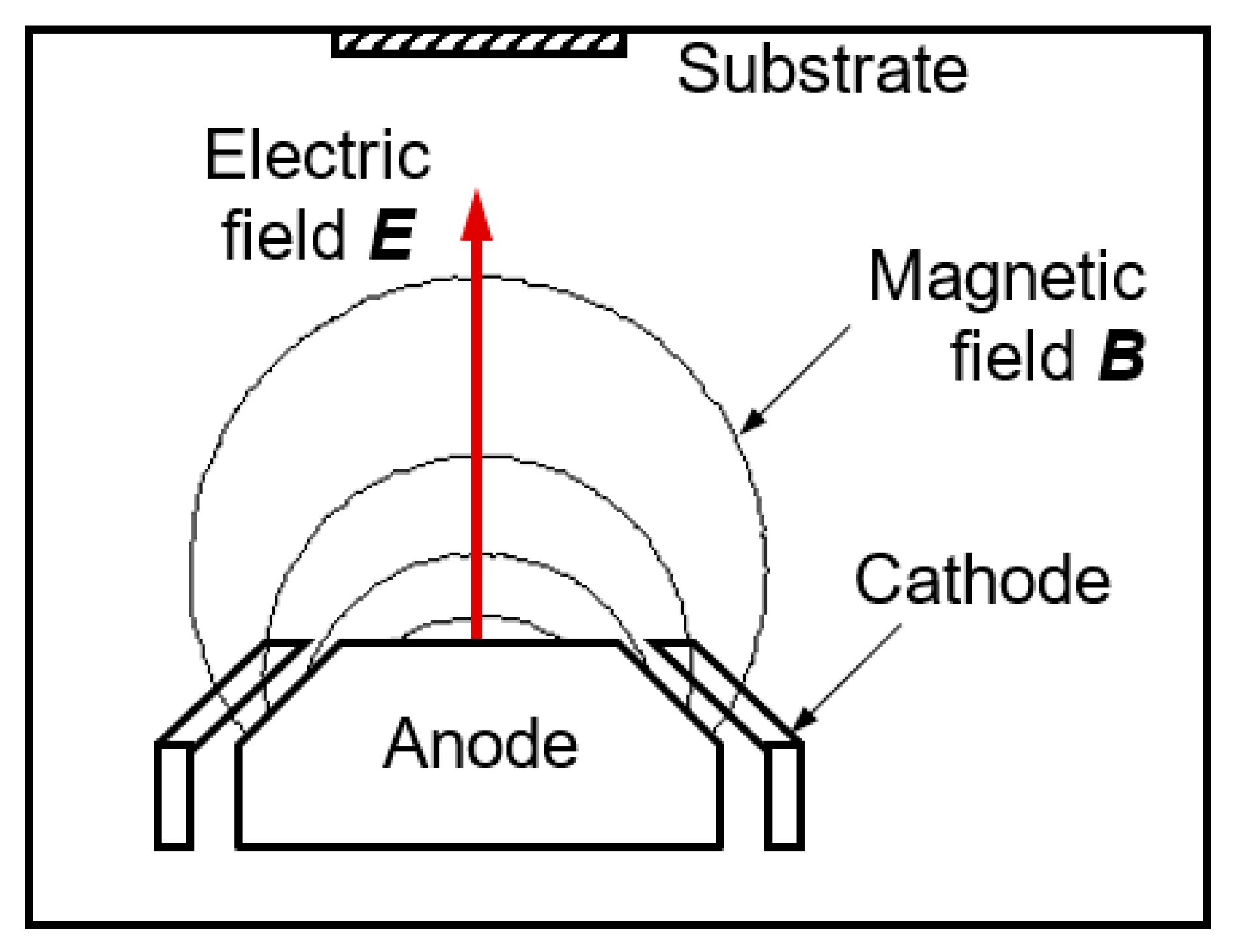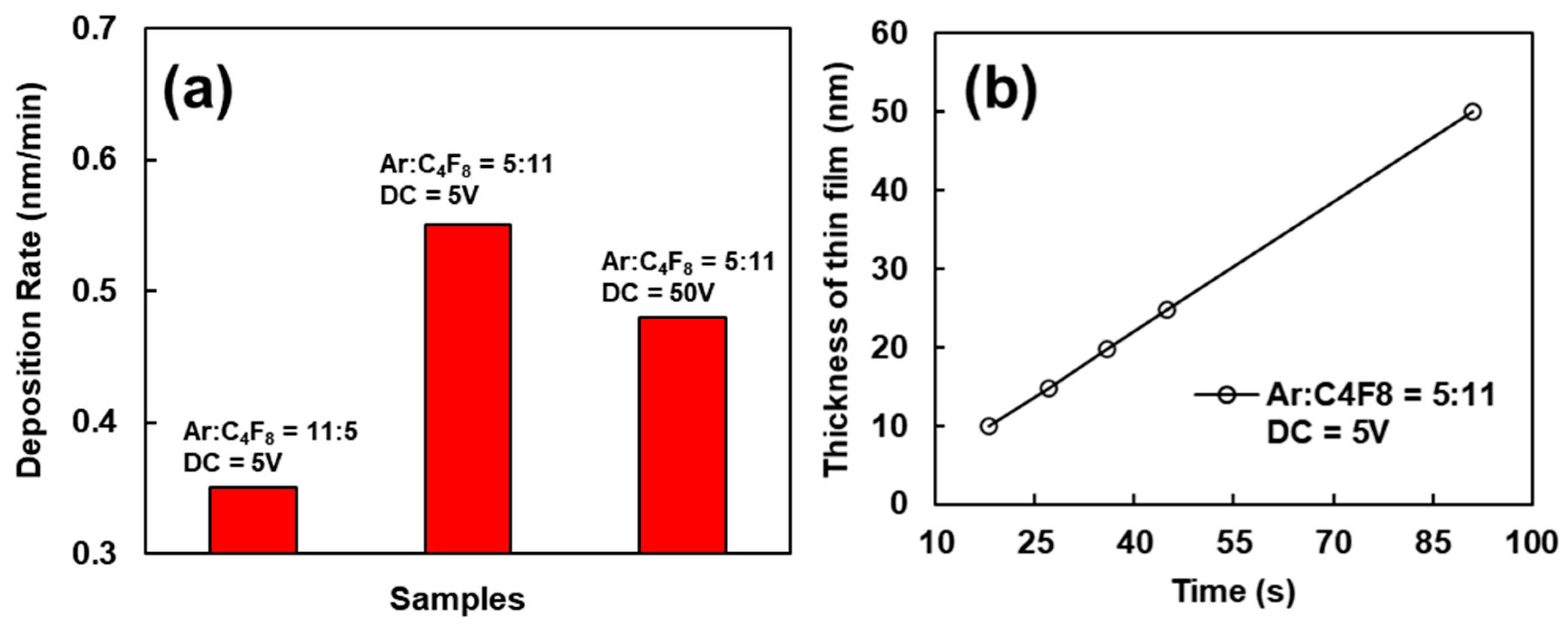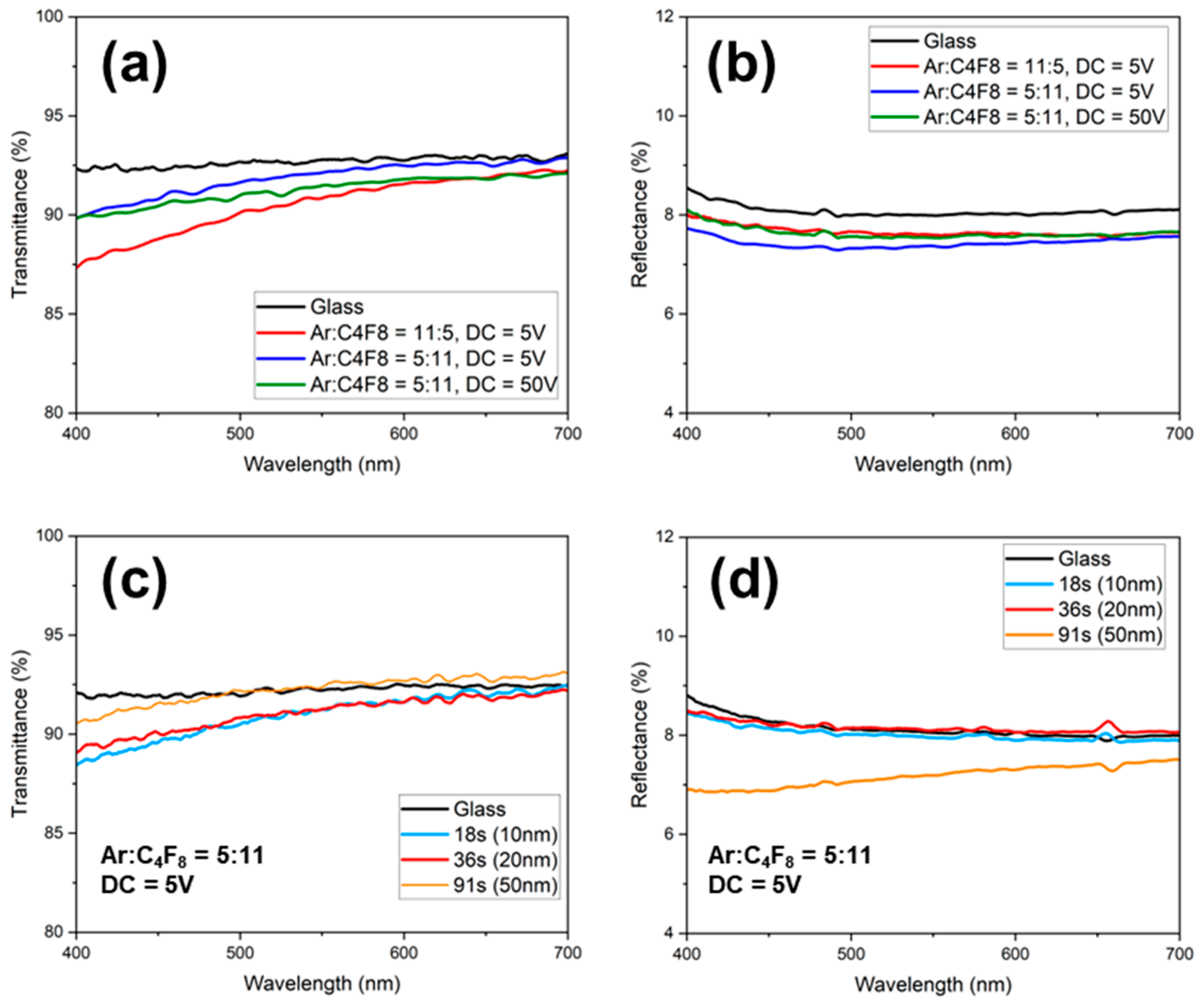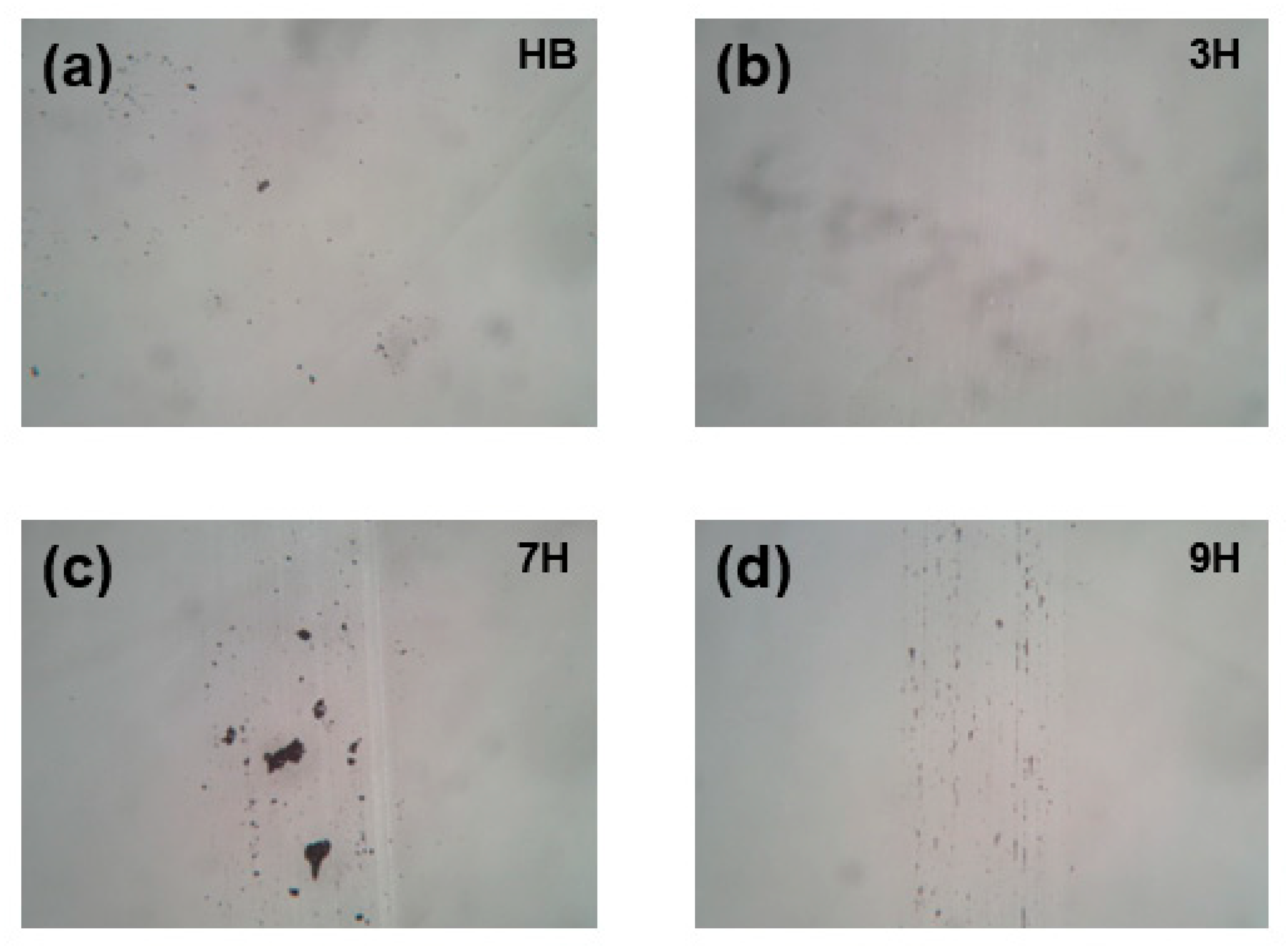Beam Plasma Source-Enhanced Deposition of Hydrophobic Fluorocarbon Thin Films
Abstract
1. Introduction
2. Materials and Methods
3. Results and Discussion
3.1. Beam Plasma Source Characteristics
3.2. Wettability of Fluorocarbon Thin Films
3.3. OES Characterization
3.4. Optical Properties
3.5. Scratch Resistance
4. Conclusions
Author Contributions
Funding
Institutional Review Board Statement
Informed Consent Statement
Data Availability Statement
Conflicts of Interest
References
- Li, J.; Niu, J.; Kim, Y.; Chae, H. Surface wettability control and fluorination modeling of amorphous carbon films fluorinated with CF4 plasma. Appl. Surf. Sci. 2023, 635, 157668. [Google Scholar] [CrossRef]
- Jiang, X.; Wang, J.; Shen, J.; Li, R.; Yang, G.; Huang, H. Improvement of adhesion strength and scratch resistance of fluorocarbon thin films by cryogenic treatment. Appl. Surf. Sci. 2014, 288, 44–50. [Google Scholar] [CrossRef]
- Kim, S.H.; Kim, M.; Lee, J.H.; Lee, S. Moisture barrier films containing plasma polymer fluorocarbon/inorganic multilayers fabricated via continuous roll-to-roll sputtering. Plasma Process. Polym. 2018, 15, 1700221. [Google Scholar] [CrossRef]
- Yamamoto, H.; Ohkubo, Y.; Ogawa, K.; Utsumi, K. Application of a chemically adsorbed fluorocarbon film to improve demolding. Precis. Eng. 2009, 33, 229–234. [Google Scholar] [CrossRef]
- Wu, H.; Qasim, A.M.; Xiao, S.; Huang, Q.; Zhang, F.; Wu, Z.; Fu, R.K.Y.; Wu, G.; Chu, P.K. Magnetron-sputtered fluorocarbon polymeric film on magnesium for corrosion protection. Surf. Coat. Technol. 2018, 352, 437–444. [Google Scholar] [CrossRef]
- Kim, H.; Shin, J.K.; Kwon, D.H.; Seo, H.I.; Lee, G.S. Plasma-Enhanced Chemical Vapor Deposition Growth of Fluorinated Amorphous Carbon Thin Films Using C4 F8 and Si2 H6/He for Low-Dielectric-Constant Intermetallic-Layer Dielectrics. Jpn. J. Appl. Phys. 2005, 44, 4886. [Google Scholar] [CrossRef]
- Koshel, D.; Ji, H.; Terreault, B.; Côté, A.; Ross, G.G.; Abel, G.; Bolduc, M. Characterization of CFx films plasma chemically deposited from C3F8/C2H2 precursors. Surf. Coat. Technol. 2003, 173, 161–171. [Google Scholar] [CrossRef]
- Wang, J.; Song, X.; Li, R.; Shen, J.; Yang, G.; Huang, H. Fluorocarbon thin film with superhydrophobic property prepared by pyrolysis of hexafluoropropylene oxide. Appl. Surf. Sci. 2012, 258, 9782–9785. [Google Scholar] [CrossRef]
- Tay, B.K.; Sheeja, D.; Lau, S.P.; Guo, J.X. Study of surface energy of tetrahedral amorphous carbon films modified in various gas plasma. Diam. Relat. Mater. 2003, 12, 2072–2076. [Google Scholar] [CrossRef]
- Liu, C.; Fairhurst, R.G.; Ren, L.Q.; Green, S.M.; Tong, J.; Arnell, R.D. Co-deposition of titaniumypolytetrafluoroethylene films by unbalanced magnetron sputtering. Surf. Coat. Technology. 2002, 149, 143–150. [Google Scholar] [CrossRef]
- Chang, C.-A.; Kim, Y.-K.; Schrott, A.G. Adhesion studies of metals on fluorocarbon polymer films. J. Vac. Sci. Technol. A Vac. Surf. Film. 1990, 8, 3304–3309. [Google Scholar] [CrossRef]
- Kim, Y.; Baule, N.; Shrestha, M.; Zheng, B.; Schuelke, T.; Fan, Q.H. Single-beam plasma source deposition of carbon thin films. Rev. Sci. Instrum. 2022, 93, 113908. [Google Scholar] [CrossRef] [PubMed]
- Tran, T.; Kim, Y.; Baule, N.; Shrestha, M.; Zheng, B.; Wang, K.; Schuelke, T.; Fan, Q.H. Single-beam ion source enhanced growth of transparent conductive thin films. J. Phys. D Appl. Phys. 2022, 55, 395202. [Google Scholar] [CrossRef]
- Arai, S.; Kazunori Tsujimoto, K.T.; Shin’ichi Tachi, S.T. Deposition in Dry-Etching Gas Plasmas. Jpn. J. Appl. Phys. 1992, 31, 2011. [Google Scholar] [CrossRef]
- Grischke, M.; Bewilogua, K.; Trojan, K.; Dimigen, H. Application-oriented modifications of deposition processes for diamond-like-carbon-based coatings. Surf. Coat. Technol. 1995, 74–75, 739–745. [Google Scholar] [CrossRef]
- Zhao, S.-X.; Zhang, Y.-R.; Gao, F.; Wang, Y.-N.; Bogaerts, A. Bulk plasma fragmentation in a C4F8 inductively coupled plasma: A hybrid modeling study. J. Appl. Phys. 2015, 117, 243303. [Google Scholar] [CrossRef]
- Lim, N.; Efremov, A.; Kwon, K.-H. A Comparison of CF4, CHF3 and C4F8 + Ar/O2 Inductively Coupled Plasmas for Dry Etching Applications. Plasma Chem. Plasma Process. 2021, 41, 1671–1689. [Google Scholar] [CrossRef]
- Nakano, T.; Samukawa, S. Effects of Ar dilution on the optical emission spectra of fluorocarbon ultrahigh-frequency plasmas: C4F8 vs CF4. J. Vac. Sci. Technol. A Vac. Surf. Film. 1999, 17, 686–691. [Google Scholar] [CrossRef]
- Labelle, C.B.; Donnelly, V.M.; Bogart, G.R.; Opila, R.L.; Kornblit, A. Investigation of fluorocarbon plasma deposition from c-C4F8 for use as passivation during deep silicon etching. J. Vac. Sci. Technol. A Vac. Surf. Film. 2004, 22, 2500–2507. [Google Scholar] [CrossRef]
- Ma, J.; Kim, J.-H.; Na, J.; Min, J.; Lee, G.-H.; Jo, S.; Kim, C.S. Enhanced Polymerization and Surface Hardness of Colloidal Siloxane Films via Electron Beam Irradiation. ACS Omega 2021, 6, 13384–13390. [Google Scholar] [CrossRef] [PubMed]








Disclaimer/Publisher’s Note: The statements, opinions and data contained in all publications are solely those of the individual author(s) and contributor(s) and not of MDPI and/or the editor(s). MDPI and/or the editor(s) disclaim responsibility for any injury to people or property resulting from any ideas, methods, instructions or products referred to in the content. |
© 2025 by the authors. Licensee MDPI, Basel, Switzerland. This article is an open access article distributed under the terms and conditions of the Creative Commons Attribution (CC BY) license (https://creativecommons.org/licenses/by/4.0/).
Share and Cite
Lee, J.; Wang, K.; Malhado, C.; Fan, Q.H. Beam Plasma Source-Enhanced Deposition of Hydrophobic Fluorocarbon Thin Films. Coatings 2025, 15, 110. https://doi.org/10.3390/coatings15010110
Lee J, Wang K, Malhado C, Fan QH. Beam Plasma Source-Enhanced Deposition of Hydrophobic Fluorocarbon Thin Films. Coatings. 2025; 15(1):110. https://doi.org/10.3390/coatings15010110
Chicago/Turabian StyleLee, Junwoo, Keliang Wang, Carson Malhado, and Qi Hua Fan. 2025. "Beam Plasma Source-Enhanced Deposition of Hydrophobic Fluorocarbon Thin Films" Coatings 15, no. 1: 110. https://doi.org/10.3390/coatings15010110
APA StyleLee, J., Wang, K., Malhado, C., & Fan, Q. H. (2025). Beam Plasma Source-Enhanced Deposition of Hydrophobic Fluorocarbon Thin Films. Coatings, 15(1), 110. https://doi.org/10.3390/coatings15010110






